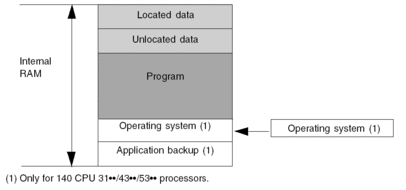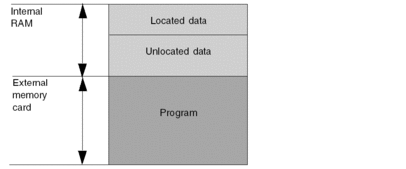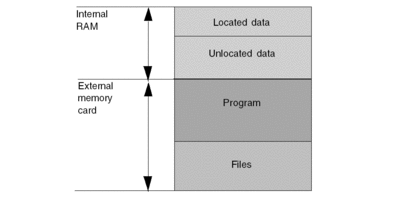General
The PLC memory supports:
located application data (State Ram),
unlocated application data,
the program: task descriptors and executable code, initial values and configuration of inputs/outputs.
Structure without Memory Extension Card
The data and program are supported by the internal RAM of the processor module.
The following diagram describes the memory structure.

Structure with Memory Extension Card
Quantum 140 CPU 6••• processors can be fitted with a memory extension card.
The data is supported by the internal RAM of the processor module.
The program is supported by the extension memory card.
The following diagram describes the memory structure.

Memory Backup
The internal RAM is backed up by a Ni-Cad battery supported by the processor module.
The RAM memory cards are backed up by a Ni-Cad battery.
Start-up with Application Saved in Backup Memory
The following table describes the different results according to the PLC state, according to the PLC mem switch, and also indicates if the box "Auto RUN" is checked or not checked.
PLC State |
PLC Mem Switch1 |
Auto RUN in Appl2 |
Results |
|---|---|---|---|
NONCONF |
Start or Off |
Off |
Cold Start, application is loaded from Backup memory to RAM of the PLC. The PLC remains in STOP. |
NONCONF |
Start or Off |
On |
Cold Start, application is loaded from Backup memory to RAM of the PLC. The PLC remains in RUN. |
NONCONF |
Mem Prt or Stop |
Not Applicable |
No application loaded. PLC power up in NONCONF state. |
Configured |
Start or Off |
Off |
Cold Start, application is loaded from Backup memory to RAM of the PLC. The PLC remains in STOP. |
Configured |
Start or Off |
On |
Cold Start, application is loaded from Backup memory to RAM of the PLC. The PLC remains in RUN. |
Configured |
Mem Prt or Stop |
Do not Care |
Warm Start, no application loaded. PLC powers up in previous state. |
1 Start and Stop are valid for the 434 and 534 models only and Off is valid for the 311 only. Mem Prt is valid on all models. 2 The Automatic RUN in the application refers to the application that is loaded. |
|||
Specificities of Memory Cards
Three types of memory card are offered:
application: these cards contain the application program. The cards on offer use either RAM or Flash EPROM technology
application + file storage: in addition to the program, these cards also contain a zone which can be used to backup/restore data using the program. The cards on offer use either RAM or Flash EPROM technology
file storage: these cards can be used to backup/restore data using the program. These cards use SRAM technology.
The following diagram describes the memory structure with an application and file storage card.



